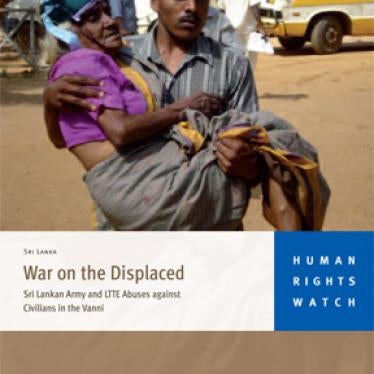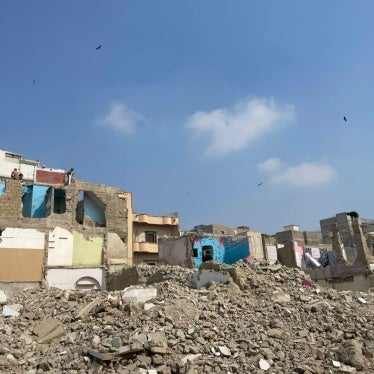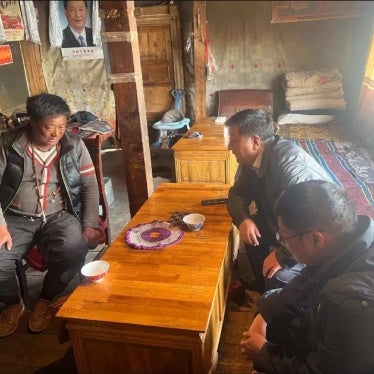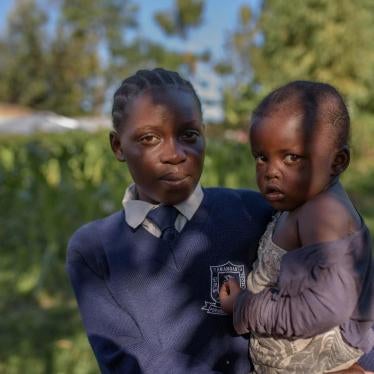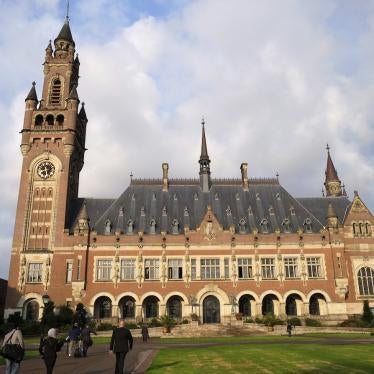(Kakinada, India) - Horrific accounts from refugees fleeing the fighting in Sri Lanka by boat show the wanton disregard for civilians of both Sri Lankan government forces and the Liberation Tigers of Tamil Eelam (LTTE), Human Rights Watch said today. Human Rights Watch called on both the United Nations Security Council and the UN Human Rights Council to make the situation in Sri Lanka a priority to avoid further loss of civilian life.
"The Sri Lankan government is doing everything it can to keep these stories of suffering from reaching the world," said Meenakshi Ganguly, senior Asia researcher at Human Rights Watch. "These accounts must be multiplied tens of thousands of times to capture the full horror of those who remain trapped by the Tamil Tigers and shelled by government forces."
Human Rights Watch interviewed a group of Sri Lankan refugees in Andhra Pradesh in India. The refugees were rescued on April 29, 2009, from Indian waters, where they had been lost at sea for nine days after fleeing from the government declared "no-fire zone" in northern Sri Lanka's Mullaitivu district. Accounts by refugees are especially important because the Sri Lankan government has long refused independent access to the combat zone for journalists and human rights monitors. The refugees' detailed statements contradict claims by the government that it is not using heavy weapons in the "no-fire zone."
A motorbike taxi driver, S. Indra Kumar, told Human Rights Watch that his family went to Putumattalan, on the coast, after the Sri Lankan government declared the area a safe zone: "We were living in such fear. There was constant shelling. On April 5 or 6, our neighbors were injured in the shelling. A shell landed inside the bunker. Ten people were injured, and of them, five died. There was no anesthesia. The doctors had to cut off a girl's hand without any anesthesia. My small daughter was crying and scared. I decided then that we had to leave."
He said that sometimes the shelling lasted so long that people could not come out to use the toilets: "Whenever there was shelling, we were in the bunker. There was heavy shelling, and the people were easing themselves in the bunker. I would take a bucket to clean up the mess and bury it in the sand."
His brother, S. Indra Meenan, a 25-year-old hardware engineer, described long periods of shelling: "In the village, every house had a bunker. Five or six people sitting inside, sometimes for three or four hours." He said that the Tamil Tigers sometimes fired from areas close to where the civilians were living, putting them at risk from retaliatory fire. "We left [by boat] on April 20 because we were scared. There was so much bombing and shelling. Every day, at least three or four hours, there was shelling. The firing was coming from the Sri Lankan army."
A mason, Sivadasa Jagdeshwaran, whose wife and 4-year-old son died on the boat journey to India, described his family's ordeal: "In the beginning, before we came to the safe zone, the government hospital was still there. My wife just had a baby, so she needed medicine. But there was no medicine at the hospital. I waited a whole day for medicines.
"The ICRC [International Committee of the Red Cross] was giving tents, but they could not cope with the demand. We built a shelter with coconut thatch. And when it rained or there was shelling, we ran to the bunker. There was shortage of food. One day, I was waiting in queue for food and there was suddenly shelling. I ran away, but later heard that 40 people had died."
Jagdeshwaran described trying to bury his father, who was hit by a shell in the safe area when he was riding his bicycle: "Many people have died. Whenever they heard there were bodies, they would collect for burial. Two months ago, my father went missing. I went to the hospital to look for my father. I found his body. The entire back of his head was missing. Only his face was there. We asked the doctor to do something to his head so we could bury him, but they said we should just be grateful that we had a body to bury."
The refugees described conditions along the sandy coastal strip where the fighting currently is ongoing. Some were able to use tents provided by the ICRC, while others huddled into makeshift shacks made of sheets and coconut fronds. They found it difficult to dig bunkers into sand. Some of those who had boats buried them in the sand to provide a base, and then created a roof of coconut tree logs and leaves. This was the only protection they had from the shelling. They also described shortages of food and medicine. S. Indra Kumar, the motorbike taxi driver, said: "The government was sending some grain. But if the need was for 100 kilos, they were sending 25 kilos. There were no NGOs [nongovernmental organizations], no medicines inside."
The refugees detailed to Human Rights Watch their harrowing journeys by boat to India, in which many died. The boat owner, Mariyada Yesudas, whose father, sister, nephew and two brothers and his uncle, the captain of the boat, died during the journey, said they felt they had no choice but to leave the safe area: "The army was really close. The LTTE was also very close. We thought the fighting had reached us. So we decided to leave before it was too late ... The army is very powerful and the LTTE was running away. How could it be safe for us?"
The accounts show the urgent need for safe humanitarian corridors for civilians to flee the fighting.
S. Indra Meenan, the hardware engineer, said: "We left at night when the shelling stopped. We were 21 people. No one saw our boat. Not the LTTE, not the army. No one tried to stop us. The boat driver had said that he would take enough food and water for us."
He said that the boat driver told them the trip to India would take nine hours. But they got lost, the motor stopped running and they ran out of fuel. They just drifted until they ran out of food and water: "We were drinking salt water. One by one, the people started dying. First it was the children. My brother's little daughter died."
Jagdeshwaran, the mason, told Human Rights Watch about the journey by boat that included his wife and two children and his wife's relatives: "My son died on April 24, four days after getting on the boat. He was 4 years old. We had no water, no food on the boat. Then her father died. Her two brothers jumped into the sea. My wife was in shock. She was weak and not even able to move. That morning, April 29, she asked for some water. We gave her seawater. She vomited and then she passed away."
Their 8-month-old son, having been fed on breast milk until his mother's death, survived.
Human Rights Watch called on the UN Human Rights Council in Geneva to hold a special session on the current situation in Sri Lanka. Human Rights Watch also reiterated its call for the UN Security Council to place Sri Lanka on its agenda and to create a commission of inquiry to investigate violations of international humanitarian law by both sides.
"While the Human Rights Council has sat on its hands, the Security Council has repeatedly failed to discuss Sri Lanka in a way that would permit even the mildest action," said Ganguly. "Given the gravity of the situation, both UN bodies need to come to grips with the scale of the disaster."
